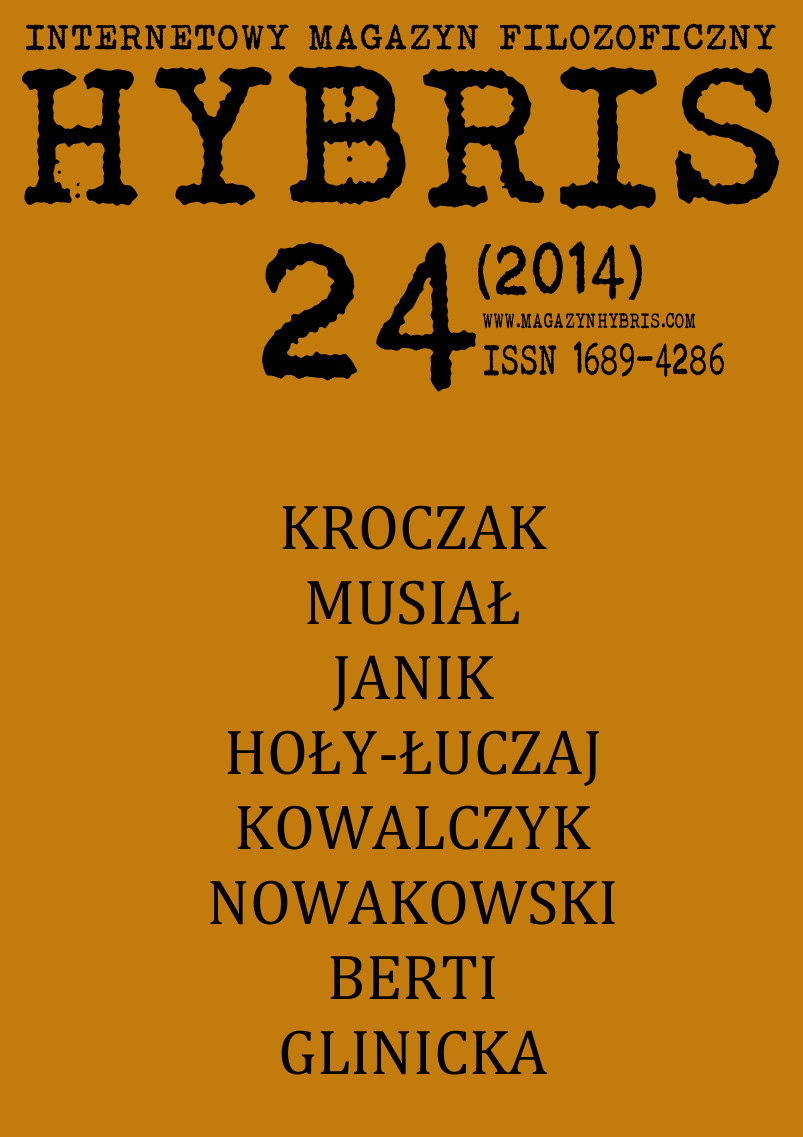Naturalizacja absolutu. Zastosowanie mechanizmów eksplanacyjnych ewolucjonizmu do badań nad religią
DOI:
https://doi.org/10.18778/1689-4286.24.05Abstrakt
The question which has troubled scholars for many decades (or even centuries) is the origin and function of religion. In this article, the author tries to sketch an outline of a new and promising paradigm in the study of religion, i.e. the evolutionary theories of religion. It is widely held belief that this enterprise should further provide an explanatory framework for an enormous amount of data about human religiosity. Such an aim requires giving an overview of the three fundamental Darwinian theories which pertain to this extremely multifaceted phenomenon. The sequence in the overview is like this: (a) a historical and conceptual background, (b) a sociobiological account, (c) a cognitive account, (d) a memetic account. The paper also comprises a short presentation of so-called co-evolutionary perspective, which integrates the above-mentioned outlooks, and some shortcomings of the whole evolutionary program of the study of religion.
Bibliografia
Barrett, Justin L., 2008, Keeping „Science” in the Cognitive Science of Religion, [w:] Joseph Bulbulia, Richard Sosis, Erica Harris i in. (red.), The Evolution of Religion. Studies, Theories & Critiques, Santa Margarita: Collins Foundation Press, ss. 295–301.
Zobacz w Google Scholar
Blackmore, Susan, 2002, Maszyna memowa, przeł. Norbert Radomski, Poznań: Rebis.
Zobacz w Google Scholar
Blume, Michael, 2009, The Reproductive Benefits of Religious Affilation, [w:] Eckart Voland, Wulf Schiefenhövel (red.), The Biological Evolution of Religious Mind and Behavior, Nowy Jork: Springer-Verlag, ss. 117–126.
Zobacz w Google Scholar
DOI: https://doi.org/10.1007/978-3-642-00128-4_8
Brockman, John, 1996, Powstaje trzecia kultura, [w:] J. Brockman (red.), Trzecia kultura, przeł. Piotr Amsterdamski i in., Warszawa: CiS, ss. 15–36.
Zobacz w Google Scholar
Dawkins, Richard, 1996, Samolubny gen, przeł. Marek Skoneczny, Warszawa: Prószyński i S-ka.
Zobacz w Google Scholar
Dawkins, Richard, 2003, A Devil's Chaplain: Reflections on Hope, Lies, Science, and Love, Nowy Jork: Houghton Mifflin Harcourt.
Zobacz w Google Scholar
Dennett, Daniel, 2008, Odczarowanie. Religia jako zjawisko naturalne, przeł. Barbara Stanosz, Warszawa: PIW.
Zobacz w Google Scholar
Fetchenhauer, Detlef, 2009, Evolutionary Perspectives on Religion – What They Can and What They Cannot Explain (Yet), [w:] Eckart Voland, Wulf Schiefenhövel (red.), The Biological Evolution of Religious Mind and Behavior, Nowy Jork: Springer-Verlag, ss. 275–291.
Zobacz w Google Scholar
DOI: https://doi.org/10.1007/978-3-642-00128-4_19
Flis, Andrzej, 2003, Chrześcijaństwo i Europa. Studia z dziejów cywilizacji Zachodu, Kraków: Nomos.
Zobacz w Google Scholar
Gell-Mann, Murray, 2002, Plectics: The study of simplicity and complexity, “Europhysics News”, nr 33, ss. 17–20.
Zobacz w Google Scholar
DOI: https://doi.org/10.1051/epn:2002105
Grzymała-Moszczyńska, Halina, 2004, Religia a kultura. Wybrane zagadnienia z kulturowej psychologii religii, Kraków: Wydawnictwo Uniwersytetu Jagiellońskiego.
Zobacz w Google Scholar
Martin, Luther H., 2008, Can Religion Really Evolve? (And What Is It Anyway?), [w:] Joseph Bulbulia, Richard Sosis, Erica Harris i in. (red.), The Evolution of Religion. Studies, Theories & Critiques, Santa Margarita: Collins Foundation Press, ss. 349–355.
Zobacz w Google Scholar
McIntosh, Daniel N., 1995, Religion-as-schema, with implications for the relation between religion and coping, “The International Journal for the Psychology of Religion”, nr 5, 1–16.
Zobacz w Google Scholar
DOI: https://doi.org/10.1207/s15327582ijpr0501_1
Newberg, Andrew; d’Aquili, Eugene i Rause, Vince, 2001, Why God Won't Go Away: Brain Science and the Biology of Belief, Nowy Jork: Ballantine Books.
Zobacz w Google Scholar
Nowaczyk, Mirosław, 1989, Ewolucjonizm kulturowy a religia, Warszawa: PWN.
Zobacz w Google Scholar
Persinger, Michael, 2002, The temporal lobe: The biological basis of the God Experience, [w:] Rhawn Joseph (red.), Neurotheology: Brain, science, spirituality, religious experience, San Jose: University Press, ss. 273–278.
Zobacz w Google Scholar
Piątek, Zdzisława, 2007, Pawi ogon czyli o biologicznych uwarunkowaniach kultury, Kraków: Wydawnictwo Uniwersytetu Jagiellońskiego.
Zobacz w Google Scholar
Rosenberg, Alex i McShea, Daniel W., 2008, Philosophy of Biology. A Contemporary Introduction, Nowy Jork: Routledge.
Zobacz w Google Scholar
Smolin, Lee, 1997, Życie wszechświata: Nowe spojrzenie na kosmologię, przeł. Danuta Czyżewska, Warszawa: Amber.
Zobacz w Google Scholar
Sosis, Richard, 2004, The Adaptive Value of Religious Ritual. Rituals Promote Group Cohesion by Requiring Members to Engage in Behavior that is too Costly to Fake, „American Scientist”, nr 92, ss. 166–172.
Zobacz w Google Scholar
DOI: https://doi.org/10.1511/2004.46.928
Stone, Linda i Lurquin, Paul F., 2009, Geny, kultura i ewolucja człowieka. Synteza, przeł. Wojciech Branicki, Wiesław Więckowski, Warszawa: Wydawnictwo Uniwersytetu Warszawskiego.
Zobacz w Google Scholar
Thomson, J. Anderson i Aukofer, Clare, 2011, Why we believe in god(s). A Concise Guide to the Science of Faith, Charlottesville 2011: Pitchstone Publishing.
Zobacz w Google Scholar
Wężowicz-Ziółkowska, Dobrosława, 2008, Moc narrativum. Idee biologii we współczesnym dyskursie humanistycznym, Katowice: Wydawnictwo Uniwersytetu Śląskiego.
Zobacz w Google Scholar
Wilson, David S., 2003, Darwin’s Cathedral: Evolution, Religion and the Nature of Society, Chicago: The University of Chicago Press.
Zobacz w Google Scholar
Wilson, Edward O., 1975, Sociobiology: The New Synthesis, Harvard: Belknap Press.
Zobacz w Google Scholar
Wright, Richard, 2004, Moralne zwierzę. Dlaczego jesteśmy tacy, a nie inni: psychologia ewolucyjna a życie codzienne, przeł. Hanna Jankowska, Warszawa: Prószyński i S-ka.
Zobacz w Google Scholar
Wszołek, Stanisław, 2004, Wprowadzenie do filozofii religii, Kraków: WAM.
Zobacz w Google Scholar
Pobrania
Opublikowane
Jak cytować
Numer
Dział
Licencja

Utwór dostępny jest na licencji Creative Commons Uznanie autorstwa – Użycie niekomercyjne – Bez utworów zależnych 4.0 Międzynarodowe.






